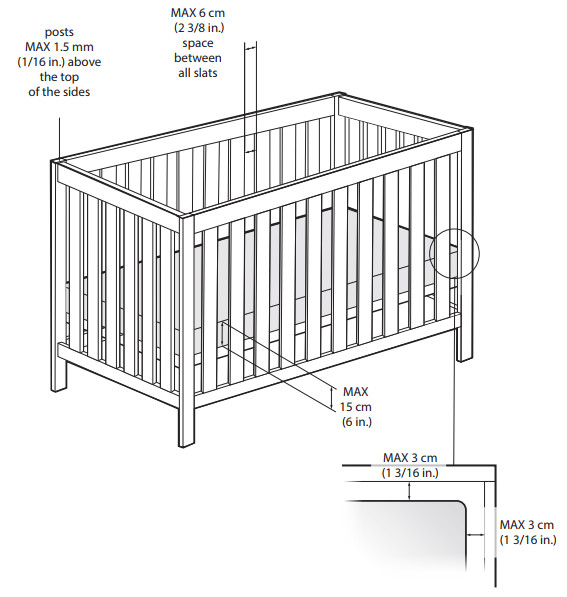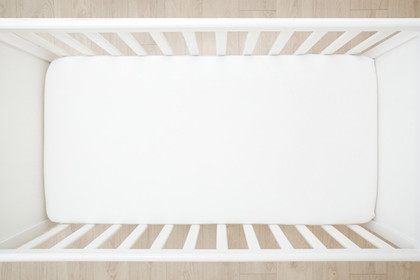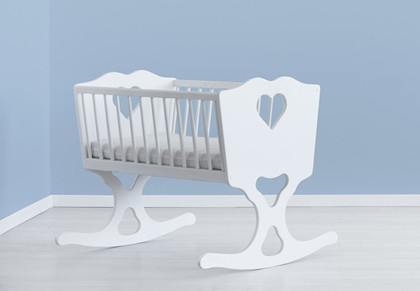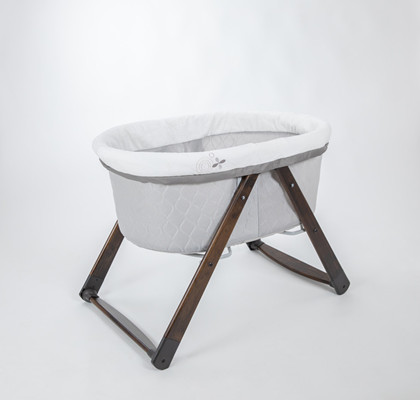Cribs, cradles and bassinets
Know what to look for when buying and setting up a crib, cradle or bassinet and how to use them safely.
On this page
- About
- Do a safety check before you buy or borrow
- Used products
- Setting up your crib, cradle or bassinette
- Transitioning to the next bed
- Other products
About
Babies sleep a lot. The safest place for your baby to sleep, at naptime and overnight, is on their back in a crib, cradle or bassinet free from soft items.
It's important to keep these spaces safe for your baby to make every sleep a safe one.
Do a safety check before you buy or borrow
All new and used cribs, cradles and bassinets sold in Canada must meet current safety regulations. This includes items:
- sold:
- at garage sales
- at second-hand stores
- through personal sales
- through online second-hand retailers
- borrowed
- given away for free
Refer to the Cribs, Cradles and Bassinet Regulations or ask the seller for more information.
When buying a crib, cradle or bassinet, check for:
- the date of manufacture
- a product label with the model name or number
- clear instructions on how to assemble and use the product
Get out your measuring tape and check that:
- slats are spaced no more than 6 centimetres apart
- corner posts are no higher than 1.5 millimetres above the top of the sides of the crib
When shopping for a mattress that comes with the product or is sold separately, check that:
- the mattress is firm
- some crib mattresses have a soft side and a firm side–make sure the firm side of the mattress is facing up.
- the mattress is tight-fitting
- the gap between the sides of the crib, cradle or bassinet and the mattress is no bigger than 3 centimetres
- push the mattress up against 1 side of the crib and then measure the gap on the other side to make sure that it is 3 centimetres or less
- the gap between the sides of the crib, cradle or bassinet and the mattress is no bigger than 3 centimetres
- the mattress is the right thickness
- for crib mattresses, not thicker than 15 centimetres
- for cradle and bassinet mattresses, not thicker than 3.8 centimetres
Use the diagram to help measure the posts, mattress and spaces between the slats on your crib.

Figure 1 - Text description
A line drawing shows a bare crib and its mattress. The image show the dimensions that consumers should measure before using or buying a crib. It points to sections of the crib. The top of a crib post shows that posts should not be more than 1.5 millimetres or 1-sixteenth of an inch above the top of the crib’s sides. The space between 2 slats should not exceed 6 centimetres or 2 and 3-eights inches. The mattress thickness should not be more than 15 centimetres or 6 inches. On the lower right side, the image zooms in on a corner of the crib where the mattress should be a maximum of 3 centimetres or 1 and 3-sixteenth inches away from the sides of the crib.
Before you check out, check on safety. Make sure the crib, cradle or bassinet you want to buy hasn't been recalled. Visit the recalls and safety alerts database.
Used products
If you're borrowing or buying a used crib, cradle or bassinet, make sure it comes with the manufacturer's instructions or that the instructions are available online. Instructions should include the model and, date of manufacturer to check for product recalls, and the assembly instructions and warnings to assemble it correctly.
Cribs made before September 1986 should not be used. They don't meet current safety regulations like slat spacing. Babies can get their head trapped between slats that are spaced too far apart.
As of December 29, 2016, it's illegal to sell, import, manufacture or advertise traditional drop-side cribs in Canada. Drop-side cribs are not safe and have been linked to injuries and deaths.
It may be tempting to use a crib that has been passed down from a friend or family member. Remember that older cribs carry risks. A baby can become trapped, strangled or suffocated.
If you buy a used crib, cradle or bassinet or it is more than 10 years old check for any missing, loose, worn, broken or damaged parts:
- replace the mattress if it's worn out or soft:
- a soft mattress can suffocate your baby
- a worn-out mattress can have sharp springs and loose threads that can harm your baby
- check that all wood and metal parts:
- have no loose nuts or bolts
- have no cracks or bent parts
- are free of splinters, sharp edges and points and other defects
It's not safe to modify these products or to repair them without parts from the original manufacturer. Parts you find around the house or at a hardware store are not safe options. If you cannot get parts from the manufacturer for the crib, cradle or bassinet, then dispose of the product according to your municipality's guidelines to prevent injury and further use.
Setting up your crib, cradle or bassinet
Follow the manufacturer's instructions when setting up your crib, cradle or bassinet. Place it away from items that may be unsafe, such as:
- lamps
- curtains
- windows
- blind cords
- patio doors
- wall hangings
- other furniture
- electrical plugs, extension cords and electrical cords
- such as those found on lamps or baby monitors
To keep your baby safe, check that the product is sturdy and that any screws and bolts are tight.
When your baby can sit upright or push up on their hands and knees, it's important to:
- remove mobiles and toy bars
- move the crib mattress support to its lowest level
Babies can suffocate in cribs, cradles and bassinets because of objects around them. You can reduce the risk by following these tips:
- Use a fitted bottom sheet made specifically for a crib, cradle or bassinet mattress of the same size.
- Loose or baggy sheets can be unsafe.
- Keep pillows, blankets, comforters, sleep positioners, stuffed toys or bumper pads out of the crib, cradle or bassinet. Bare is best.
- Don't harness or tie your baby to their crib, cradle or bassinet or use a crib tent.
- If you're worried about your baby climbing or falling out, consider transitioning them to the next bed.
- Don't put your baby to sleep with any type of cord nearby (for example, a necklace, scarf or pacifier cord). Remember that cords and kids don't mix.
- Don't place a baby lounger or baby nest (also called a baby pod) inside a crib, cradle or bassinet.
- The soft, padded sides could suffocate your baby.
Learn about the risks associated with soft products and baby nests and loungers:
Transitioning to the next bed
Sleep safety changes as your baby changes. Cribs, cradles and bassinets are designed for children at certain stages of development. If you wish to buy only 1 product, choose a crib. A crib will accommodate a range of age and weight limits for longer than a bassinet or a cradle.
Follow the manufacturer's recommended age, weight and height limit for the product. To keep your baby safe as they grow and change, move them from:
- a bassinet to a crib or cradle when they can roll over
- a cradle to a crib when they can push up on their hands and knees
- a crib to a junior bed when they can climb out on their own or are taller than 90 centimetres, whichever comes first
Other products
Cribs, cradles and bassinets are the safest place for your baby to sleep. Other options that you can consider for your baby include baby boxes and playpen bassinet attachments that meet current Canadian safety regulations.
Baby boxes
A baby box is a box that is often filled with items to help care for your baby during the first months of life. Some baby boxes can also be used as a safe sleep space. They are a low-cost, accessible and portable option.
Before using a baby box as a sleep space for your baby, check with the provider that it complies with the Crib, Cradle and Bassinet Regulations. Also follow these guidelines:
- remove all items from the box
- follow all instructions for use
- check the box regularly to make sure that leaks and spills have not caused the sides or bottom of the box to break down
- place the box on a flat, non-elevated and stable surface
- only move the box when your baby is not inside
- leave the box uncovered while your baby is inside
- follow safe sleep tips for every sleep
Playpens
Playpens are not recommended for sleep because they are not as durable and safe as cribs.
Bassinet attachments for playpens can be used for sleep until your baby can roll over or reaches the attachment's weight limit, whichever comes first. Make sure to assemble these attachments according to the manufacturer's instructions.
Learn more:


